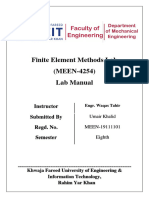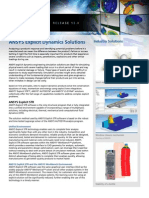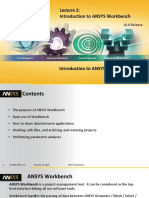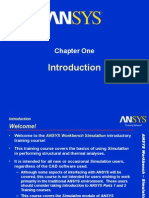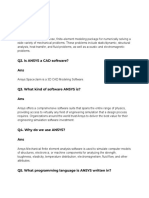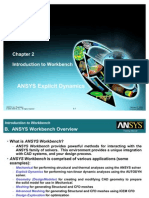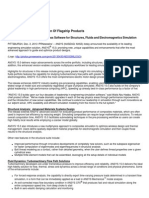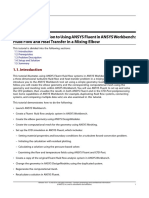ANSYS Workbench 12.1
ANSYS Workbench 12.1
Uploaded by
Mit GuptaCopyright:
Available Formats
ANSYS Workbench 12.1
ANSYS Workbench 12.1
Uploaded by
Mit GuptaCopyright
Available Formats
Share this document
Did you find this document useful?
Is this content inappropriate?
Copyright:
Available Formats
ANSYS Workbench 12.1
ANSYS Workbench 12.1
Uploaded by
Mit GuptaCopyright:
Available Formats
ANSYS Workbench Platform
TM
1 2 .1 R E L E A S E
ANSYS WorkbenchEnabled Products
The ANSYS Workbench framework hosts the following software products and components: 4 Common Tools and Capabilities ANSYS CAD connections ANSYS DesignModeler ANSYS Meshing ANSYS DesignXplorer FE Modeler 4 Fluid Dynamics ANSYS CFX ANSYS FLUENT ANSYS Icepak ANSYS POLYFLOW 4 ANSYS Multiphysics 4 Structural Mechanics ANSYS Mechanical ANSYS Structural ANSYS Professional 4 Explicit Dynamics ANSYS Explicit STR ANSYS AUTODYN ANSYS LS-DYNA (setup-only in ANSYS Workbench) 4 Electromagnetics ANSYS Emag 4 Turbo System ANSYS BladeModeler ANSYS TurboGrid ANSYS Vista TF 4 Offshore ANSYS AQWA
Changing the Way Engineers Interact with Simulation
ANSYS Workbench is the framework upon which the industrys broadest suite of advanced engineering simulation technology is built. An innovative project schematic view ties together the entire simulation process, guiding the user every step of the way. Even complex multiphysics analyses can be performed with drag-and-drop simplicity. With bidirectional CAD connectivity, an automated project update mechanism, pervasive parameter management and integrated optimization tools, the ANSYS Workbench platform delivers unprecedented productivity that truly enables Simulation Driven Product Development.
TM
The Next Generation of ANSYS Workbench With the release of ANSYS 12, the underlying ANSYS Workbench framework has been reengineered. An innovative project schematic view transforms the way engineers work with simulation. Projects are represented graphically as connected systems in a flowchart-like diagram. At a glance, users can easily understand engineering intent, data relationships and the state of the analysis project.
TM
The new project schematic view shows an overall view of the entire simulation project. Engineering intent, data relationships and the state of the entire project are visible at a glance, even for complex analyses involving multiple physics.
Working with the new project system is straightforward: simply drag the desired analysis system from the toolbox at left and drop it into the project schematic. Complete analysis systems contain all of the necessary components, guiding you through the analysis process as you work through the system from top to bottom.
ANSYS Workbench Journaling and Scripting
Operations executed within the ANSYS Workbench platform can be recorded to a Python-based journal that can be replayed to easily recreate an ANSYS Workbench session. Users can modify the journal or write a new set of instructions to create a custom ANSYS Workbench script for automating repetitive tasks or performing complex operations. Journals and scripts can be replayed interactively or in batch mode when ANSYS Workbench is launched. ANSYS Workbench scripting is based on the versatile, object-oriented Python scripting language, which provides a rich set of data types and standard libraries for efficient programming. Furthermore, the Python implementation used in ANSYS Workbench is well integrated with the .NET Framework (Windows) and Mono (Linux), providing interoperability with popular programs like Microsoft Excel to access ANSYS Workbench parameters, perform external calculations and drive the overall simulation process. In addition to replaying journal files, ANSYS Workbench provides a command window to invoke individual commands. Keyboard shortcuts, command-completion and commandrecall facilitate command window interaction and reduce tedious typing. Many applications hosted in ANSYS Workbench support their own scripting languages (e.g., ANSYS Mechanical APDL), and these application-specific commands can be embedded in an ANSYS Workbench script. This coordination between ANSYS Workbench and its applications provides comprehensive scripting support of the complete engineering simulation process.
The entire process is persistent. Changes can be made to any portion of the analysis and the ANSYS Workbench platform will manage the execution of the required applications to update the project automatically, dramatically reducing the cost of performing design iterations.
After dragging the desired analysis system into the project schematic, work through the system from top to bottom to complete your analysis. Icons in the right of each cell clearly indicate progress. Here the analysis is complete through meshing.
Drag-and-Drop Multiphysics The ANSYS Workbench platform has been engineered for scalability. Building complex, coupled analyses involving multiple physics is as easy as dragging in a follow-on analysis system and dropping it onto the source analysis. Required data transfer connections are formed automatically. As an example, consider the one-way fluid structure interaction (FSI) simulation shown schematically below.
www.ansys.com
Drag-and-drop multiphysics: forming a link in the project schematic (at left) achieves data transfer between the different physics, and creates imported loads in the downstream simulation (shown inside the ANSYS Mechanical application at right).
12.1 RELEASE
The ANSYS Workbench platform automatically forms a connection to share the geometry for both the fluid and structural analyses, minimizing data storage and making it easy to study the effects of geometry changes on both analyses. In addition, a connection is formed to automatically transfer pressure loads from the fluid analysis to the structural analysis. Flexible Project Construction Complete analysis systems are convenient because they contain all of the necessary tasks or components to complete start-to-finish simulations for a wide variety of physics. The project schematic has also been designed to be very flexible. You can connect component systems task-oriented, building block systemsin a wide variety of ways to suit your analysis needs.
ANSYS Workbench Features
4 Bidirectional, parametric links with
all major CAD systems
4Integrated, analysis-focused
Here component systems have been used to represent a specific intent. A common mesh is used for analyses in ANSYS CFX and ANSYS FLUENT products, and the results are compared in the ANSYS CFD-Post tool using the Results system at right.
Chain systems together to achieve creative solutions to real-world engineering problems. Shown above is a static structural analysis that was performed to determine the deformation of a structure in response to applied loads. An ANSYS Parametric Design Language (APDL) script was used to export the mesh for the deformed shape to FE Modeler. FE Modeler was used to synthesize a geometry that was then used to perform modal analysis of the deformed shape.
Project-Level Parameter Management As always, the applications hosted in the ANSYS Workbench environment support parametric variations, including CAD geometry dimensions, material properties, boundary conditions and derived results. Parameters defined within the applications can be managed directly from the project window, making it easy to investigate multiple variations of an analysis. From within the project window, a series of design points can be defined and executed to complete a what-if study with a single operation. To fully leverage the power of parametric analysis, ANSYS DesignXplorer software extends the ANSYS Workbench platform to drive Design of Experiments, goal-driven optimization, min/max search or even perform Six Sigma analysis to investigate design robustness. All of this power is available across all applications, all physics and all solvers available within the ANSYS Workbench environment, including ANSYS Mechanical APDL.
geometry modeling, repair, and simplification via ANSYS DesignModeler 4Highly-automated, physics-aware meshing 4Automatic contact detection 4Unequalled depth of capabilities within individual physics disciplines 4Unparalleled breadth of simulation technologies 4Complete analysis systems that guide the user start-to-finish through an analysis 4Comprehensive multiphysics simulation with drag-and-drop ease of use 4Flexible components enable tools to be deployed to best suit engineering intent 4Innovative project schematic view allows engineering intent, data relationships, and the state of the project to be comprehended at a glance 4Complex project schematics can be saved for re-use 4Pervasive, project-level parameter management across all physics 4Automated what-if analyses with integrated design point capability 4Adaptive architecture with scripting and journaling capabilities and APIs enabling rapid integration of new and third-party solutions
www.ansys.com
12.1 RELEASE
ANSYS DesignXplorer Leverage the Power of Parametric Analysis
ANSYS DesignXplorer software, an extension to the ANSYS Workbench platform, allows users to take full advantage of any parametric analysis. ANSYS DesignXplorer technology provides a description of the relationships between the design variables and the performance of the product by using Design of Experiments (DOE) combined with response surfaces. DOE and response surfaces provide all the information required to take advantage of Simulation Driven Product Development. When performance variations due to design variables are known, it is easy to understand and identify all changes required to meet product requirements. Once the simulations responses are characterized, ANSYS DesignXplorer software supplies different types of optimization algorithms to identify good candidates for a given design. Several graphical tools are available to investigate a design: sensitivity plots, correlation matrices, curves, surfaces, trade-off plots and parallel charts with Pareto Front display, and spider charts. They can be used at any time during the development of the product without requiring additional simulations to test new configurations. These capabilities are available across all applications and all physics. Also included are coupled analyses that allow users to perform design analyses by combining the performances from several different physics and finding the right trade-offs between potentially conflicting objectives. ANSYS DesignXplorer technology also offers probabilistic analysis techniques to determine the extent to which uncertainties in the model affect the results of an analysis and provide useful information in a Six-Sigma approach.
The ANSYS Workbench platform manages parameters for all applications and displays them in a convenient table within the project window. This example studies the effects of varying four geometry dimensions on thermal and electric behaviors. ANSYS DesignXplorer software, fully integrated into ANSYS Workbench, automatically generates a response surface illustrating the effects of varying the geometric input parameters. Design of Experiments, goal-driven optimization, Six Sigma and other design exploration methods can be added with drag-and-drop simplicity.
The ANSYS Advantage With the unequalled depth and unparalleled breadth of our engineering simulation solutions, companies are transforming their leading edge design concepts into innovative products and processes that work. Today, 97 of the top 100 industrial companies on the FORTUNE Global 500 invest in engineering simulation as a key strategy to win in a globally competitive environment. They choose ANSYS as their simulation partner, deploying the worlds most comprehensive multiphysics solutions to solve their complex engineering challenges. The engineered scalability of our solutions delivers the flexibility customers need, within an architecture that is adaptable to the processes and design systems of their choice. No wonder the worlds most successful companies turn to ANSYS with a track record of almost 40 years as the industry leader for the best in engineering simulation.
www.ansys.com
ANSYS, Inc. Southpointe 275 Technology Drive Canonsburg, PA 15317 U.S.A. 724.746.3304 ansysinfo@ansys.com
Toll Free U.S.A./Canada: 1.866.267.9724 Toll Free Mexico: 001.866.267.9724 Europe: 44.870.010.4456 eu.sales@ansys.com
ANSYS, ANSYS Workbench, AUTODYN, CFX, FLUENT and any and all ANSYS, Inc. brand, product, service and feature names, logos and slogans are registered trademarks or trademarks of ANSYS, Inc. or its subsidiaries in the United States or other countries. ICEM CFD is a trademark used under license. All other brand, product, service and feature names or trademarks are the property of their respective owners. Image Credits: Some images courtesy FluidDA nv, Forschungszentrum Jolich GmbH, Heat Transfer Research, Inc., Riello SPA and iStockphoto.com 2009 ANSYS, Inc. All Rights Reserved. Printed in U.S.A. MKT0000550 12-09
You might also like
- Finite Element Analysis for Design Engineers, Second EditionFrom EverandFinite Element Analysis for Design Engineers, Second EditionNo ratings yet
- ASP.NET For Beginners: The Simple Guide to Learning ASP.NET Web Programming Fast!From EverandASP.NET For Beginners: The Simple Guide to Learning ASP.NET Web Programming Fast!No ratings yet
- Ansys APDL and WBDocument3 pagesAnsys APDL and WBKristine ReyesNo ratings yet
- Lab Session 01 - MEEN201101022Document8 pagesLab Session 01 - MEEN201101022muhamad mubeenNo ratings yet
- Ansys Workbench: DR A.Gopichand M.Tech, PH.DDocument35 pagesAnsys Workbench: DR A.Gopichand M.Tech, PH.DgopichandallakaNo ratings yet
- WK 14 - Intro To FEA and ANSYS WorkbenchDocument7 pagesWK 14 - Intro To FEA and ANSYS WorkbenchMian AsimNo ratings yet
- What Is AnsysDocument3 pagesWhat Is AnsysKashif HayatNo ratings yet
- The Role of Modeling in ParametricDocument3 pagesThe Role of Modeling in ParametricJuyong KimNo ratings yet
- Assignment 3Document7 pagesAssignment 3110-ME-2K20 Harshit pandeyNo ratings yet
- Meen 19111101 (Umair Khalid)Document166 pagesMeen 19111101 (Umair Khalid)Haid AshfaqueNo ratings yet
- Simulation SoftwaresDocument20 pagesSimulation SoftwaresTayyabNo ratings yet
- Develop3D Reviews ANSYSDocument3 pagesDevelop3D Reviews ANSYSShashank RajoriaNo ratings yet
- NX Advanced Simulation Fs W18Document10 pagesNX Advanced Simulation Fs W18jegjegtNo ratings yet
- Ansys CFD BrochureDocument4 pagesAnsys CFD BrochuresamniumNo ratings yet
- Lecture 1: Overview of FSI in Workbench: ANSYS Fluent Fluid Structure Interaction (FSI) With ANSYS MechanicalDocument38 pagesLecture 1: Overview of FSI in Workbench: ANSYS Fluent Fluid Structure Interaction (FSI) With ANSYS MechanicalAtsis PapadopoulosNo ratings yet
- Meen 19111063Document109 pagesMeen 19111063foruseopen29No ratings yet
- Ansys CFD PostDocument2 pagesAnsys CFD PostSaumya SinhaNo ratings yet
- Lecture 1.1: Introduction To ANSYS Workbench: ANSYS Fluent Getting Started - Part 1Document14 pagesLecture 1.1: Introduction To ANSYS Workbench: ANSYS Fluent Getting Started - Part 1Rafael MunguíaNo ratings yet
- ANSYS Explicit R13 PDFDocument4 pagesANSYS Explicit R13 PDFSç-č AbabiiNo ratings yet
- Graphics System in Vehicle ElectronicsDocument6 pagesGraphics System in Vehicle ElectronicsAbdulBasit ShaikhNo ratings yet
- ANSYS Workbench 14.0 For Engineers and DesignersDocument1 pageANSYS Workbench 14.0 For Engineers and DesignersDreamtech Press25% (4)
- Introduction To Ansys Workbench 16.0 PDFDocument12 pagesIntroduction To Ansys Workbench 16.0 PDFTran Van TienNo ratings yet
- AWS90 Ch01 IntroDocument32 pagesAWS90 Ch01 IntroyuriNo ratings yet
- College ReportDocument35 pagesCollege ReportVikas DhayalNo ratings yet
- Introduction of AnsysDocument3 pagesIntroduction of Ansys20MCE 01 Mehwish KhanNo ratings yet
- Six SigmaDocument2 pagesSix Sigma123qwerty00No ratings yet
- ANSYS Workbench 10Document1,192 pagesANSYS Workbench 10Nusret MeydanlikNo ratings yet
- A Brief Overview On Modeling and Simulation SoftwareDocument7 pagesA Brief Overview On Modeling and Simulation SoftwareAli Ghalehban - علی قلعه بانNo ratings yet
- Ansys Fluent Brochure 14.0Document12 pagesAnsys Fluent Brochure 14.0Kadiri SaddikNo ratings yet
- 01 Fluid-Flow-Heat-Transfer-in-Mixing-Elbow PDFDocument75 pages01 Fluid-Flow-Heat-Transfer-in-Mixing-Elbow PDFAgungHSNo ratings yet
- Design XplorerDocument36 pagesDesign XplorerAndrey ZagorulkoNo ratings yet
- NX Advanced Simulation Fs W 9 - tcm841-4362Document9 pagesNX Advanced Simulation Fs W 9 - tcm841-4362Thyagaraj A HNo ratings yet
- ANSYS Mechanical Workbench - ANSYS Designspace - FEA Software - Mechanical Engineering Software - Mechanical EngineeringDocument11 pagesANSYS Mechanical Workbench - ANSYS Designspace - FEA Software - Mechanical Engineering Software - Mechanical EngineeringVitorHugoNo ratings yet
- Khawaja Fareed University of EngineeringDocument4 pagesKhawaja Fareed University of Engineeringmeen211101120No ratings yet
- Ansys Interviwe QuestionsDocument8 pagesAnsys Interviwe Questions20EUEE053- MADHUBALAN.SNo ratings yet
- Ansys Explicit DynamicsDocument8 pagesAnsys Explicit DynamicsMulugeta Kiros GebeyehuNo ratings yet
- Ansoft DesignerDocument12 pagesAnsoft DesignerChorintanPrabeliaNo ratings yet
- Explicit Dynamics Chapter 2 Intro To WBDocument29 pagesExplicit Dynamics Chapter 2 Intro To WBalexandrusssNo ratings yet
- ANSYS Releases New Version of Flagship ProductsDocument3 pagesANSYS Releases New Version of Flagship ProductsConstantin DorinelNo ratings yet
- Fae LabDocument9 pagesFae LabMuhammad HamzaNo ratings yet
- SIMULIA-Abaqus WCCS DatasheetDocument2 pagesSIMULIA-Abaqus WCCS DatasheetasiawiNo ratings yet
- Introduction To Using ANSYS FLUENT in ANSYS Workbench Fluid FlowDocument75 pagesIntroduction To Using ANSYS FLUENT in ANSYS Workbench Fluid FlowkrodyNo ratings yet
- WBTut 1Document72 pagesWBTut 1Ramesh Babu100% (1)
- Lab Report 01ANSYSDocument8 pagesLab Report 01ANSYSAreeba MujtabaNo ratings yet
- Broch Samcef Field AnDocument6 pagesBroch Samcef Field AnAnonymous KdnOsd9No ratings yet
- A Scalable Synthesis Methodology For Application-Specific ProcessorsDocument14 pagesA Scalable Synthesis Methodology For Application-Specific ProcessorsMurali PadalaNo ratings yet
- GS. Workflows in STAAD - ProDocument3 pagesGS. Workflows in STAAD - ProFrancis CayananNo ratings yet
- ANSYS Fluent: Name: Mustafa Khader Abdel Abbas. Stage: (Morning)Document8 pagesANSYS Fluent: Name: Mustafa Khader Abdel Abbas. Stage: (Morning)مصطفى الجبوريNo ratings yet
- 12.1 ANSYS DesignModelerDocument4 pages12.1 ANSYS DesignModelerWang BaishiNo ratings yet
- Model-Driven Online Capacity Management for Component-Based Software SystemsFrom EverandModel-Driven Online Capacity Management for Component-Based Software SystemsNo ratings yet
- Live Trace Visualization for System and Program Comprehension in Large Software LandscapesFrom EverandLive Trace Visualization for System and Program Comprehension in Large Software LandscapesNo ratings yet
- Software Engineering New Approach (Traditional and Agile Methodologies)From EverandSoftware Engineering New Approach (Traditional and Agile Methodologies)No ratings yet









